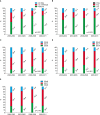Changes in Prostate Cancer Aggressiveness over a 12-Year Period in Korea
- PMID: 23136627
- PMCID: PMC3490087
- DOI: 10.4111/kju.2012.53.10.680
Changes in Prostate Cancer Aggressiveness over a 12-Year Period in Korea
Abstract
Purpose: To investigate whether tumor aggressiveness in patients with prostate cancer has changed in Korea since the introduction of prostate-specific antigen (PSA) testing.
Materials and methods: The data from 2,508 patients with pathologically confirmed prostate cancer who underwent radical prostatectomy at Asan Medical Center between 2000 and 2011 were reviewed. The patients were divided into four 3-year time series, and the changes between the groups in terms of serum PSA levels, pathological Gleason score (GS), and pathological stage were assessed. The change in GS over time in organ-confined disease and in patients whose PSA was below 10 ng/ml was also analyzed.
Results: The mean PSA levels dropped significantly over the 12-year period (p<0.001). The frequency of organ-confined disease increased (55.7% vs. 64.7% vs. 62.9% vs. 63.5%, p=0.043). The frequency of patients with a GS of 8 or more decreased (38.9% vs. 25.7% vs. 18.2% vs. 19.7%) and the frequency of patients with a GS of 6 or less increased (15.0% vs. 18.9% vs. 26.7% vs. 18.2%, p=0.003). However, the vast majority (more than 70%) of all cases had a high GS (7 or greater) at all time points. The GS distribution did not change over time in patients whose PSA levels were below 10 ng/ml or in those who had organ-confined disease.
Conclusions: In 2000 to 2011, the preoperative PSA, pathological stage, and pathological GS dropped. However, the majority of the prostate cancers in Korean men were poorly differentiated, even when the patients had organ-confined disease or their PSA levels were less than 10 ng/ml.
Keywords: Korea; Neoplasm grading; Prostatic neoplasms.
Conflict of interest statement
The authors have nothing to disclose.
Figures

Similar articles
-
Role of radical prostatectomy in patients with prostate cancer of high Gleason score.Prostate. 1999 Apr 1;39(1):60-6. doi: 10.1002/(sici)1097-0045(19990401)39:1<60::aid-pros10>3.0.co;2-u. Prostate. 1999. PMID: 10221268 Clinical Trial.
-
Stage T1-2 prostate cancer: a multivariate analysis of factors affecting biochemical and clinical failures after radical prostatectomy.Int J Radiat Oncol Biol Phys. 1997 Mar 15;37(5):1043-52. doi: 10.1016/s0360-3016(96)00590-1. Int J Radiat Oncol Biol Phys. 1997. PMID: 9169811
-
Increased body mass index as a risk factor in localized prostate cancer treated by radical prostatectomy.Urol Oncol. 2016 Jun;34(6):254.e1-6. doi: 10.1016/j.urolonc.2015.12.009. Epub 2016 Jan 25. Urol Oncol. 2016. PMID: 26822075
-
Evaluation of fatty acid synthase in prostate cancer recurrence: SUV of [(11) C]acetate PET as a prognostic marker.Prostate. 2015 Nov;75(15):1760-7. doi: 10.1002/pros.23061. Epub 2015 Aug 18. Prostate. 2015. PMID: 26282590
-
Prospective evaluation of men with stage T1C adenocarcinoma of the prostate.J Urol. 1997 Jun;157(6):2206-9. J Urol. 1997. PMID: 9146616 Free PMC article. Review.
Cited by
-
Effects of Progressive Resistance Training on Post-Surgery Incontinence in Men with Prostate Cancer.J Clin Med. 2018 Sep 19;7(9):292. doi: 10.3390/jcm7090292. J Clin Med. 2018. PMID: 30235904 Free PMC article.
-
Nonmetastatic castration-resistant prostate cancer.Korean J Urol. 2014 Mar;55(3):153-60. doi: 10.4111/kju.2014.55.3.153. Epub 2014 Mar 13. Korean J Urol. 2014. PMID: 24648868 Free PMC article.
-
Epidemiology of prostate cancer in South Korea.Prostate Int. 2015 Sep;3(3):99-102. doi: 10.1016/j.prnil.2015.06.003. Epub 2015 Jul 17. Prostate Int. 2015. PMID: 26473152 Free PMC article.
References
-
- Jemal A, Siegel R, Xu J, Ward E. Cancer statistics, 2010. CA Cancer J Clin. 2010;60:277–300. - PubMed
-
- Chi BH, Chang IH. Prostate cancer: recent trends in Korea. Urol Int. 2010;85:88–93. - PubMed
-
- Park SK, Sakoda LC, Kang D, Chokkalingam AP, Lee E, Shin HR, et al. Rising prostate cancer rates in South Korea. Prostate. 2006;66:1285–1291. - PubMed
LinkOut - more resources
Full Text Sources
Research Materials
Miscellaneous

